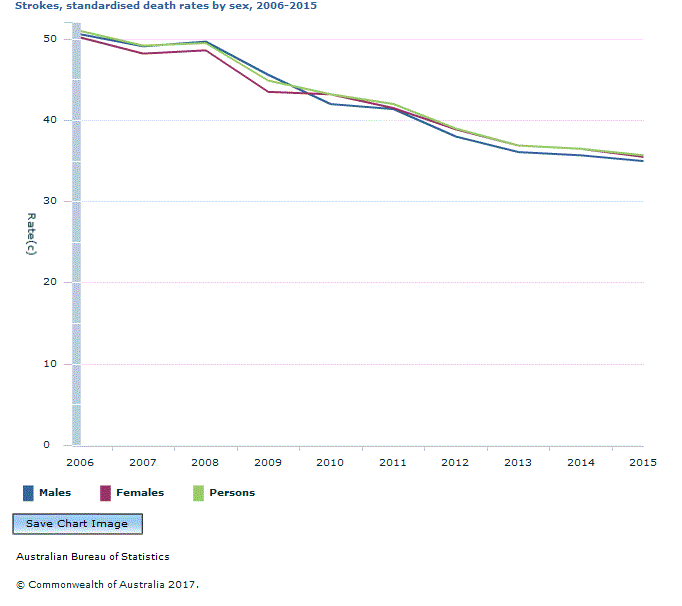Page tools:
 Print Page Print Page
 Print All Print All
| ||
STROKE Stroke is the third leading cause of death in Australia. In 2015, there were 10,869 stroke fatalities in Australia, accounting for 6.8% of the 159,052 deaths. What is a stroke? A stroke, often referred to in medical terms as a cerebrovascular accident, affects the blood flow to the brain. Strokes are a type of cerebrovascular disease, a broad term for brain dysfunctions which relate to the blood vessels that supply the brain. Most deaths from cerebrovascular diseases are due to a stroke. There are two types of stroke; cerebral haemorrhage and cerebral infarction. A haemorrhagic stroke is a bleed in the brain. An infarction is caused by a blockage, such as a blood clot or a fatty plaque, in the blood vessels supplying the brain. Either type of stroke can result in part of the brain dying (becoming ischaemic) and suddenly reducing a person’s ability to talk, speak, think clearly and control their motor functions. A person may also suffer from a transient ischaemic attack (TIA), or mini-stroke. These occur when the blood supply to the brain is interrupted temporarily. Although signs and symptoms often resolve, a mini-stroke can be a precursor to a major stroke and should be treated with the same urgency. This is reflected in the cause of death data: although only 54 people died from TIAs in 2015, they were reported as associated causes in almost 1,000 deaths. Key demographics Overall, there is little difference in the death rate for stroke between males and females, but a difference does exist across age groups. For males under the age of 85, the death rate from stroke is higher than that for females, while for those aged 85 and over the female death rate is higher. The median age at death from stroke is 86.6 years. This compares to 81.9 years for deaths from all causes. While this indicates that many deaths from stroke occur among the elderly, strokes also feature as one of the top 10 leading causes of death among people aged 45 and over. The age-standardised death rate from strokes has been decreasing for many years. Over the last ten years the death rate decreased from 51.0 deaths per 100,000 persons in 2006 to 35.7 in 2016 (See figure 1).
 Footnote(s): (a) All causes of death from 2006 onwards are subject to a revisions process - once data for a reference year are 'final', the are no longer revised. Affected data in this table are 2006-2013 (final), 2014 (revised) and 2015 (preliminary). See Explanatory Notes 52-55 and A More Timely Annual Collection: Changes to ABS Processes (Technical Note) in this publication. See also Causes of Death Revisions, 2013 Final Data (Technical Note) for further information. (b) Stroke refers to ICD-10 codes I60-I69. (c) Standardised death rates. Deaths per 100,000 of estimated mid-year population. See Glossary for further information. (d) See Explanatory Notes 68-95 for further information on specific issues related to interpreting time-series and 2015 data. Risk factors Medical risk factors for cerebrovascular disease include high blood pressure (hypertension), atrial fibrillation, high cholesterol, diabetes, and obesity. Risk factors are often (but not always) reported on death certificates, providing an indication of the prevalence of certain risk factors among those who have died from strokes. Hypertension: Hypertension or high blood pressure was reported as an associated cause in 28% of stroke deaths in 2015. High blood pressure damages blood vessel walls and can contribute to both haemorrhagic and ischaemic strokes. Risk factors for high blood pressure include age, a lack of exercise, high salt intake and smoking. Medications that control blood pressure are now commonplace and can significantly reduce the chance of stroke. Atrial fibrillation: Atrial fibrillation is a type of heartbeat irregularity that impedes the flow of blood through the heart’s chambers, allowing it to pool and clot in the vessels. It was reported as an associated cause in 11% of stroke deaths in 2015. Although atrial fibrillation is usually well-controlled through anti-clotting (anticoagulant) medication, anticoagulants slightly increase the risk of haemorrhage, including in the brain. People under treatment for atrial fibrillation need to be closely monitored by their medical practitioners. High cholesterol, obesity and diabetes: These conditions cause an excess of fat and sugar in the bloodstream, causing the hardening and narrowing of the blood vessels. Lifestyle changes targeting diet and exercise can help ameliorate the effects of these conditions, while medications such as statins have proven successful in lowering cholesterol levels and reducing the risk of strokes. While diabetes is commonly reported as an associated cause of death from heart disease or stroke, high cholesterol and diabetes are less commonly reported by medical practitioners. The prognosis While the death rate from stroke has declined over the past 10 years, it remains the third leading cause of death in Australia. Medications that mitigate key risk factors have undoubtedly reduced mortality rates from strokes, while specialised stroke recovery units have also increased survival rates. Heart disease, stroke and many cases of dementia are caused by the deterioration of blood vessels. This deterioration can be slowed by medications and treatments, but it cannot be stopped. Therefore as people grow older, their risk of mortality from these diseases will always increase. Signs of stroke In the event of a person suffering a stroke, time elapsed before medical intervention is critical to survivability and recovery. The acronym F.A.S.T. has been successfully used to raise awareness of the main symptoms of stroke and to remind people of the need to seek urgent medical assistance (Endnote 1). F.A.S.T. stands for: Facial drooping Arm weakness Speech difficulties Time to call emergency services
Bibliography 1. Stroke Foundation, viewed 7th July 2017 <https://strokefoundation.org.au/About-Stroke/Stroke-symptoms>
Document Selection These documents will be presented in a new window.
|
||
3303.0 - Causes of Death, Australia, 2015  Quality Declaration
Quality Declaration
ARCHIVED ISSUE Released at 11:30 AM (CANBERRA TIME) 26/07/2017
This page last updated 26 September 2017
